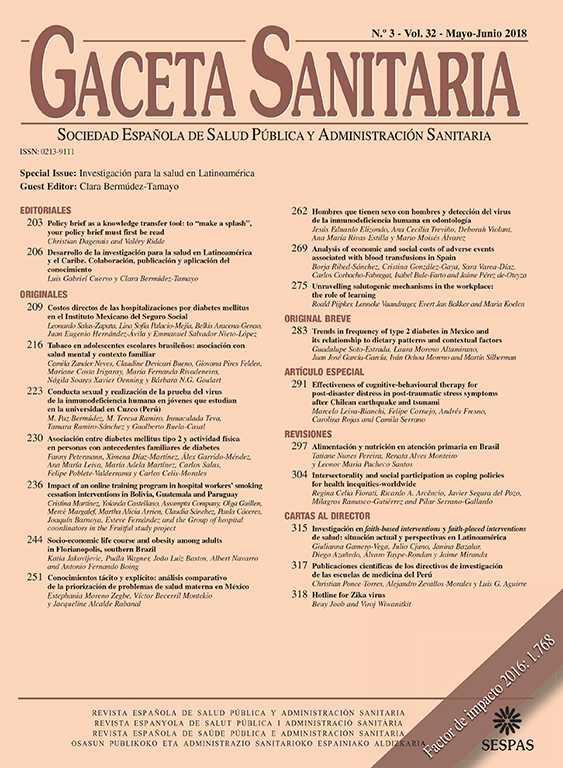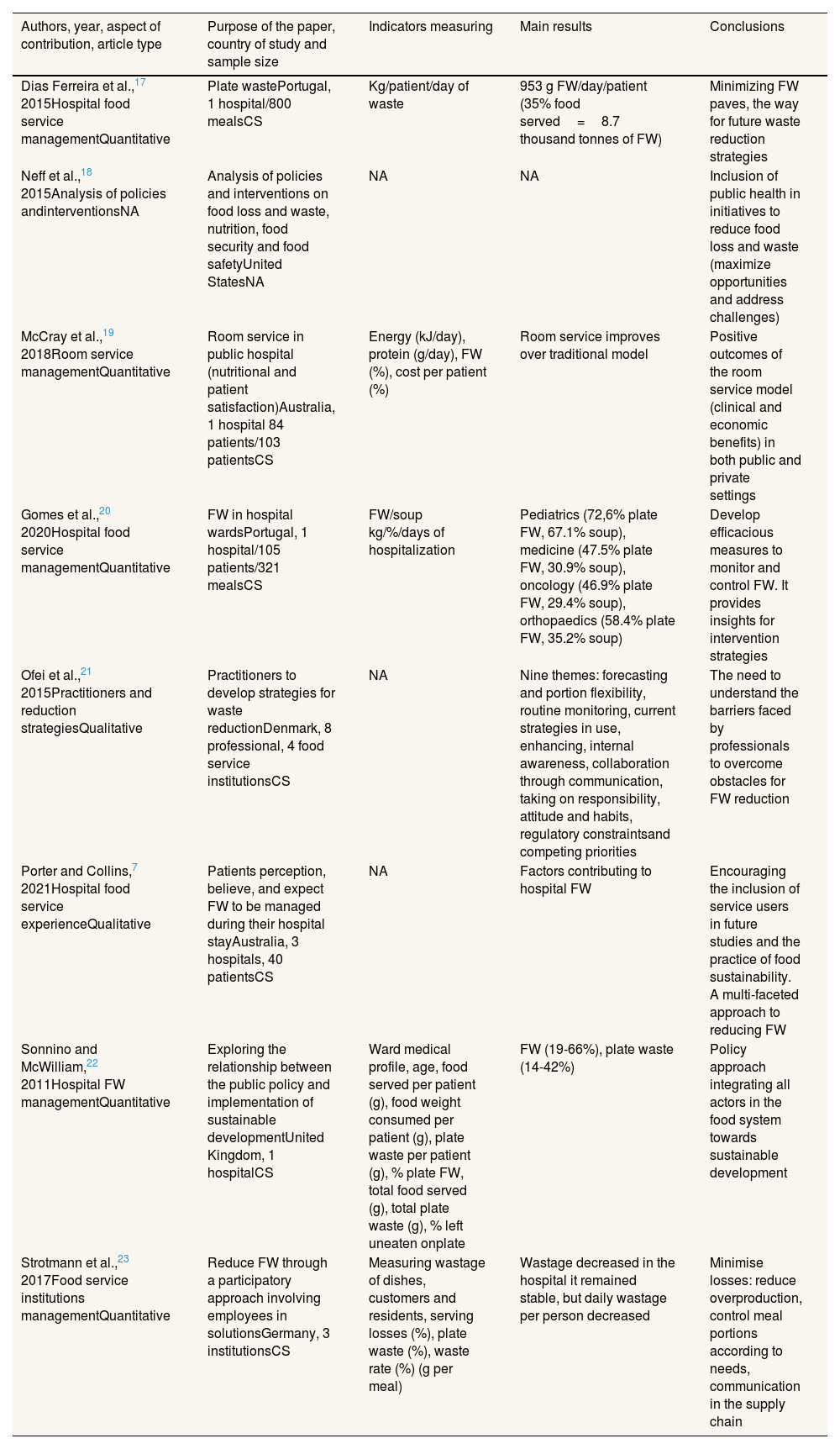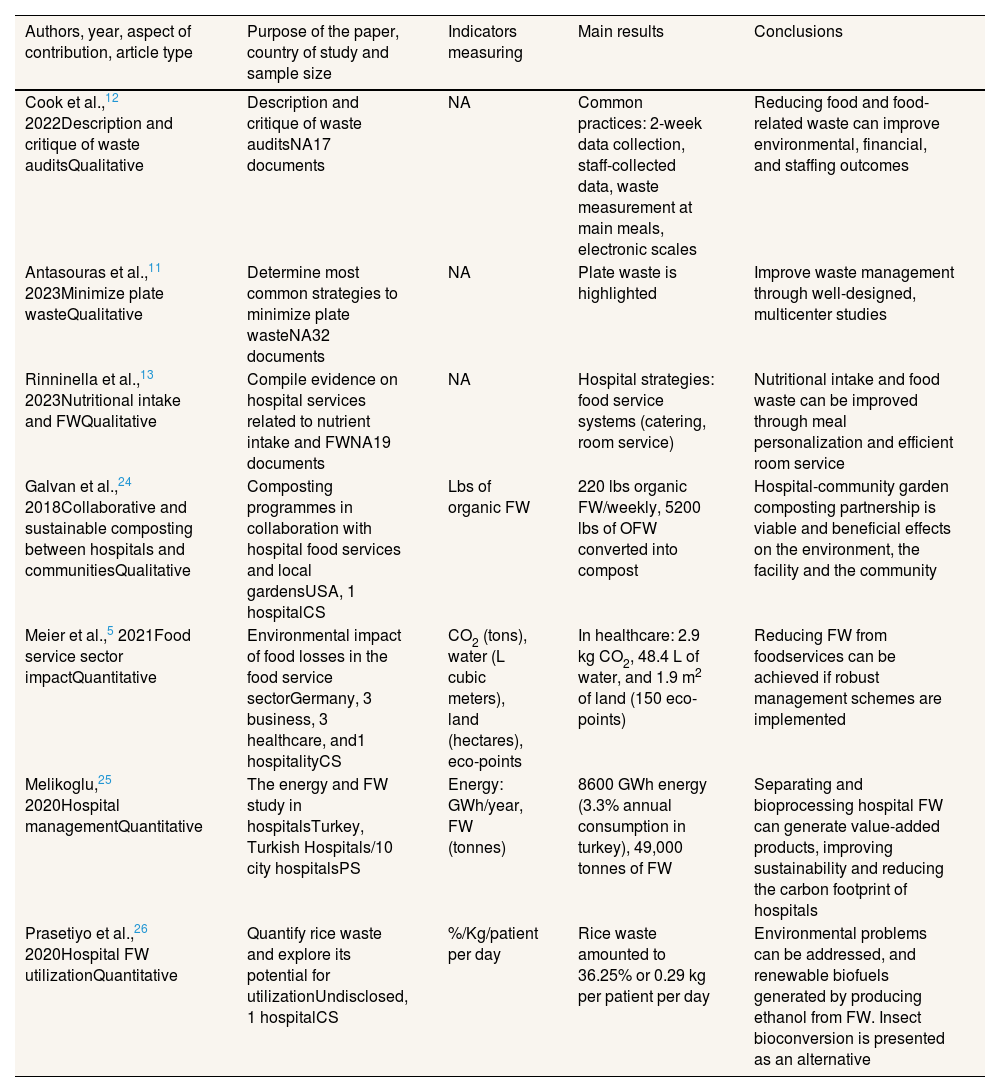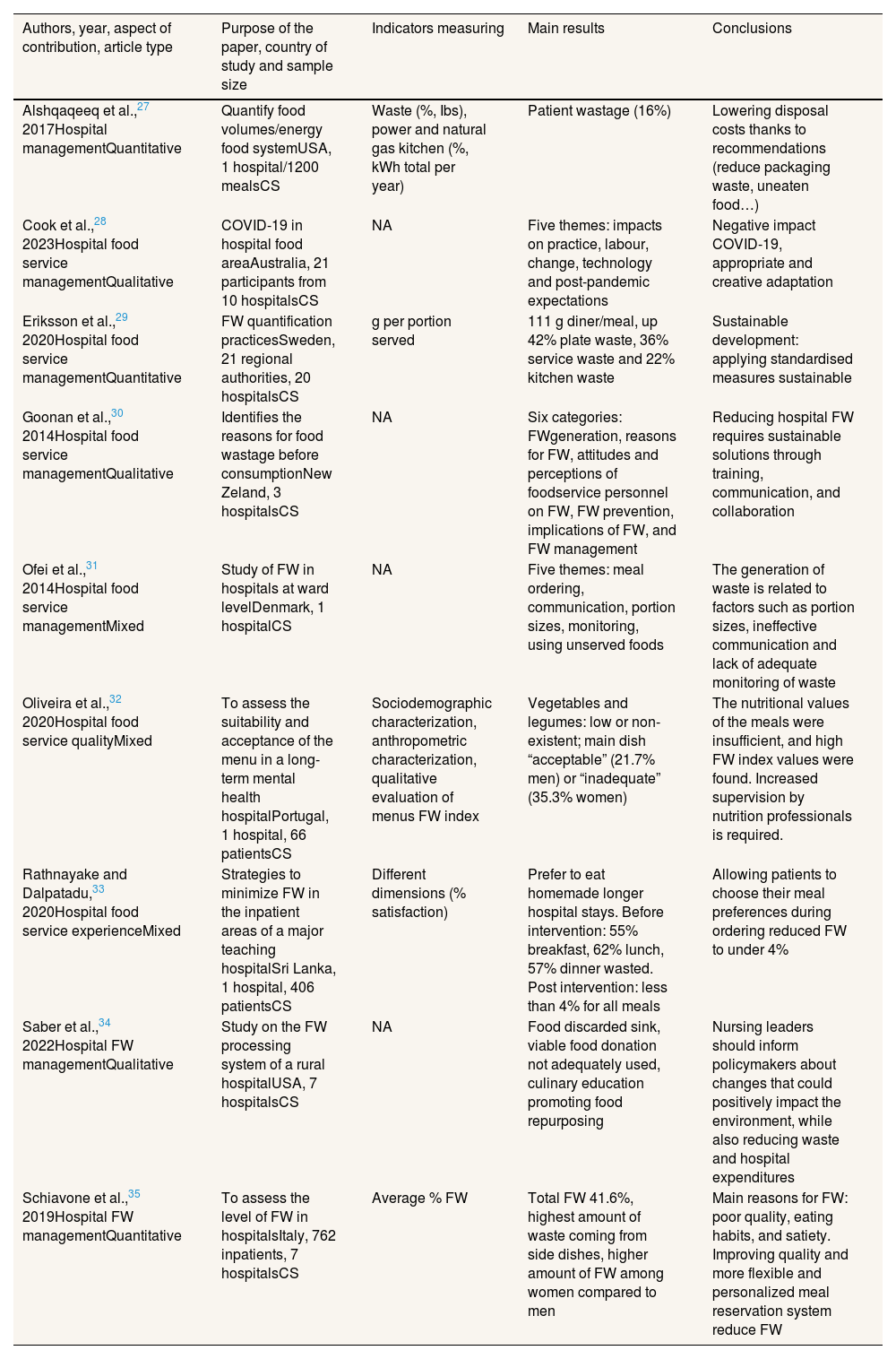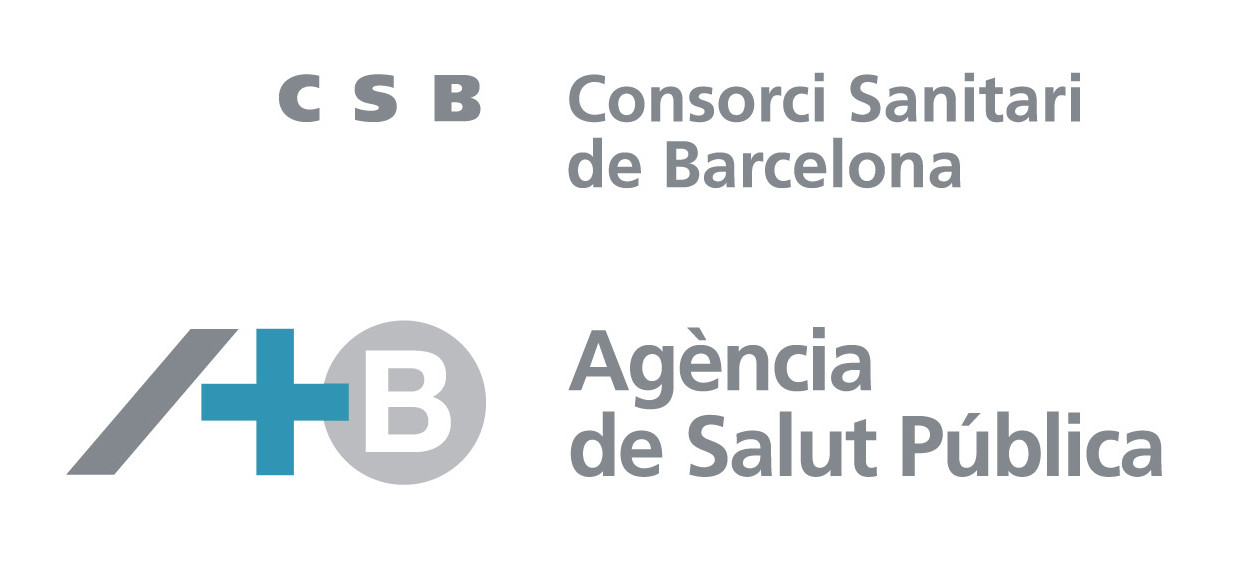To identify the most relevant research on food waste and loss in hospitals, analyse its main characteristics and investigate key findings as well as gaps in existing studies.
MethodA scoping review adapted from the PRISMA-ScR guidelines was conducted. The sample was extracted from core databases and subjected to rigorous analysis to ensure transparency and quality of the process.
ResultsThe importance of conducting research that jointly addresses wellbeing and environmental sustainability in hospitals is highlighted. In addition, the importance of properly managing food waste in hospitals is highlighted, contributing to the Sustainable Development Goals of the 2030 Agenda.
ConclusionsThe complexity of obtaining accurate and relevant information on wasted food and on the actual food needs of patients hinders efficient hospital management. It helps to identify the most promising areas for addressing the causes and consequences of food waste in hospitals. In this way, management strategies can be improved, and the well-being of patients, workers and managers can be optimised through cooperation, communication and coordination.
Identificar las investigaciones más relevantes sobre el desperdicio y la pérdida de alimentos en hospitales, analizar sus características principales e investigar los hallazgos clave, así como las lagunas en los estudios existentes.
MétodoSe llevó a cabo una revisión de alcance adaptada de las directrices PRISMA-ScR. La muestra fue extraída de bases de datos principales y sometida a un análisis riguroso para garantizar la transparencia y la calidad del proceso.
ResultadosSe destaca la importancia de llevar a cabo investigaciones que aborden conjuntamente el bienestar y la sostenibilidad ambiental en los hospitales. Además, se pone de manifiesto la importancia de gestionar adecuadamente los residuos alimentarios en los hospitales, contribuyendo a los Objetivos de Desarrollo Sostenible de la Agenda 2030.
ConclusionesLa complejidad de obtener información precisa y relevante sobre los alimentos desperdiciados y sobre las necesidades alimentarias reales de los pacientes dificulta la gestión hospitalaria eficiente. Se contribuye a identificar las áreas más prometedoras para abordar las causas y las consecuencias del desperdicio de alimentos en los hospitales. De este modo se pueden mejorar las estrategias de gestión y optimizar el bienestar de pacientes, trabajadores y gestores a través de la cooperación, la comunicación y la coordinación.
Factors affecting human health are becoming more extensive and interconnected.1 Waste management contributes to a better economy, a better quality of life and a happier workplace by reducing or eliminating negative impacts on the environment and human health.2 From an ecological perspective, it is evident that food waste and loss (FW&L) have adverse effects not only on the environment and economy, but also on human health, overall well-being, and society.3,4 To combat this situation, it is necessary to implement governmental actions, investments in infrastructure and technology, as well as the development of human capital. The implementation of effective FW&L management systems is instrumental in achieving Target 12.3 of the United Nations Sustainable Development Goals, which aims to reduce FW&L by half.5
Within the food service supply sector, healthcare institutions such as hospitals are a significant generator of FW&L.5,6 However, many hospitals remain unaware of the amount of FW&L they produce and its associated costs.
Health systems, notably hospitals, can play a pivotal role in mitigating the environmental and social impacts of FW&L. Alongside the imperative to safeguard patient health, their commitment to sustainable procurement and food systems can also yield tangible benefits for local economies.6 Furthermore, hospitals can function as conduits for education on healthy behaviours and diets, thereby establishing themselves as pivotal entities in the promotion of social well-being. Enhancing organisational performance and corporate well-being stems from cultivating a culture committed to achieving sustainable and competitive outcomes.7,8 This approach, when applied to the context of hospitals, can contribute to the reduction of FW&L through the cultivation of an organisational culture that prioritises well-being. In essence, this entails a lifestyle that prioritises personal wellbeing and satisfaction.
Health systems can be defined as the way in which healthcare is organised and delivered to individuals within a structured framework.9 Hospitals represent a critical component within these systems, functioning as central institutions where a significant proportion of care coordination, resource allocation and service delivery occurs.10 Hospitals have been identified as key players in the reduction of the environmental and social impacts of FW&L. Despite extensive consultation of the database, the number of eligible papers was found to be minimal, ranging from 17 to 32 articles, with a total of 80 in the broader study. This indicates a lack of research on FW&L management in the healthcare sector.
These previous literature reviews offer some insights into specific aspects of FW&L in hospitals, focusing on waste measures,11 audit methodologies12 and potential solutions for food intake and waste management.13 To date, no article has been found that comprehensively describes the literature on FW&L across different hospital settings. Consequently, there is a necessity for studies that compile all localised research on FW&L in different hospitals to serve as a reference. In this regard, the present article aims to address this knowledge gap by integrating diverse aspects of the research field, which are often addressed separately, with the objective of achieving a holistic perspective of the phenomenon under study.
This paper presents a scoping review, adopting the PRISMA model (PRISMA-ScR, Preferred Reporting Items for Systematic Reviews and Meta-Analyses extension for scoping review), with the intention of synthesising knowledge.14 The objective is twofold: firstly, to identify the most relevant literature on FW&L in hospitals; and secondly, to analyse their main characteristics and explore the key contributions and gaps in the research. The study sets out to address two research questions: 1) what are the main characteristics of previous literature on FW&L in hospitals?, and 2) what are the main issues and research gaps addressed on FW&L in hospitals?
MethodTo address the research questions outlined, the present study employs a scoping review methodology following the PRISMA-ScR framework developed by Tricco et al.14 in 2018 (Fig. 1). This methodological approach is particularly well-suited to synthesising existing knowledge on the topic under investigation, enabling a systematic identification of the literature's key characteristics, thematic focus, and prevailing research gaps (see Table S1 in Online Supplementary Material).
Search strategyThe research team conducted an initial search in Google Scholar to identify common keywords in the title and abstract. The keywords ‘hospital’, ‘healthcare’, ‘food waste’ and ‘food loss’ were selected to align closely with the research questions, addressing the intersection of the healthcare setting and the phenomenon of food waste and loss. These terms directly address the core elements of the research project, namely the specific setting, the main phenomenon of interest and its intersections. The selection of these terms also ensures that the search strategy encompasses the most relevant literature to answer the research questions.
Studies identificationOn 8 June 2023, the search was conducted in the Web of Science database, encompassing the Science Citation Index Expanded, the Social Sciences Citation Index, and the Emerging Sources Citation Index. The search terms “HOSPITAL” and “FOOD WASTE” or “FOOD LOSS” returned 291 records. To collect other articles that could be related to the topic, two additional searches were conducted. The first search was for “HEALTHCARE” and “FOOD WASTE” (3 records). The second search was performed using the term “HEALTHCARE” and “FOOD LOSS”, yielding no results. This search was replicated in the Scopus database, as it offers a more extensive collection of documents compared to the WoS database,15 with 55 results. The total number of records identified at the completion of the search was 349.
Records screeningThe research team examined the sample and determined the filter criteria. The selection of a specific language was excluded (although the use of English keywords was mandatory), a period was not selected, and the results were searched up to the search date (June 2023). The ‘articles only’ filter was employed to discard conference proceedings, early access, books and book chapters, and grey literature. Utilising these criteria, a total of 266 records were identified. Following the elimination of duplicates (n=14), the selection was narrowed to 252 records.
Records eligibilityThe objective of the researchers was to exclusively address articles pertaining to FW&L in hospitals. To this end, a rigorous examination of the titles and abstracts was performed. Following this, the researchers reached a consensus to resolve any discrepancies. Consequently, 227 articles were excluded on the basis that they were not pertinent to the study, and one grey literature article was identified but not included in the sample. The bias and quality analysis encountered challenges due to the limited number of studies on food waste and loss in hospitals. To capture the breadth of existing evidence, no exclusion criteria based on the quality of the journals was applied. Studies that did not directly address hospital settings, such as those focusing on hotels, general food value chains, or agricultural losses in animal and plant production, were excluded. While this approach ensured relevance to the research objective, it may have introduced a bias by limiting thematic specificity and omitting assessments of study quality. Following these exclusions, 24 articles were selected for the final sample.
Data extractionA thorough review of the search results was conducted, leading to the identification of the predominant characteristics of the extant literature on FW&L in hospitals. The main themes related to the topic were then addressed. All studies were grouped into the following categories: ‘Interventions for reducing food waste in hospitals’ (Table 1), ‘Measurement methods and utilization strategies’ (Table 2), and ‘Recommendations and other’ (Table 3). Extraction was performed (where applicable): authors, year, aspect of contribution, purpose, country of study, sample characteristics, indicators measured, main findings and conclusion.
Interventions for reducing food waste in hospitals.
| Authors, year, aspect of contribution, article type | Purpose of the paper, country of study and sample size | Indicators measuring | Main results | Conclusions |
|---|---|---|---|---|
| Dias Ferreira et al.,17 2015Hospital food service managementQuantitative | Plate wastePortugal, 1 hospital/800 mealsCS | Kg/patient/day of waste | 953 g FW/day/patient (35% food served=8.7 thousand tonnes of FW) | Minimizing FW paves, the way for future waste reduction strategies |
| Neff et al.,18 2015Analysis of policies andinterventionsNA | Analysis of policies and interventions on food loss and waste, nutrition, food security and food safetyUnited StatesNA | NA | NA | Inclusion of public health in initiatives to reduce food loss and waste (maximize opportunities and address challenges) |
| McCray et al.,19 2018Room service managementQuantitative | Room service in public hospital (nutritional and patient satisfaction)Australia, 1 hospital 84 patients/103 patientsCS | Energy (kJ/day), protein (g/day), FW (%), cost per patient (%) | Room service improves over traditional model | Positive outcomes of the room service model (clinical and economic benefits) in both public and private settings |
| Gomes et al.,20 2020Hospital food service managementQuantitative | FW in hospital wardsPortugal, 1 hospital/105 patients/321 mealsCS | FW/soup kg/%/days of hospitalization | Pediatrics (72,6% plate FW, 67.1% soup), medicine (47.5% plate FW, 30.9% soup), oncology (46.9% plate FW, 29.4% soup), orthopaedics (58.4% plate FW, 35.2% soup) | Develop efficacious measures to monitor and control FW. It provides insights for intervention strategies |
| Ofei et al.,21 2015Practitioners and reduction strategiesQualitative | Practitioners to develop strategies for waste reductionDenmark, 8 professional, 4 food service institutionsCS | NA | Nine themes: forecasting and portion flexibility, routine monitoring, current strategies in use, enhancing, internal awareness, collaboration through communication, taking on responsibility, attitude and habits, regulatory constraintsand competing priorities | The need to understand the barriers faced by professionals to overcome obstacles for FW reduction |
| Porter and Collins,7 2021Hospital food service experienceQualitative | Patients perception, believe, and expect FW to be managed during their hospital stayAustralia, 3 hospitals, 40 patientsCS | NA | Factors contributing to hospital FW | Encouraging the inclusion of service users in future studies and the practice of food sustainability. A multi-faceted approach to reducing FW |
| Sonnino and McWilliam,22 2011Hospital FW managementQuantitative | Exploring the relationship between the public policy and implementation of sustainable developmentUnited Kingdom, 1 hospitalCS | Ward medical profile, age, food served per patient (g), food weight consumed per patient (g), plate waste per patient (g), % plate FW, total food served (g), total plate waste (g), % left uneaten onplate | FW (19-66%), plate waste (14-42%) | Policy approach integrating all actors in the food system towards sustainable development |
| Strotmann et al.,23 2017Food service institutions managementQuantitative | Reduce FW through a participatory approach involving employees in solutionsGermany, 3 institutionsCS | Measuring wastage of dishes, customers and residents, serving losses (%), plate waste (%), waste rate (%) (g per meal) | Wastage decreased in the hospital it remained stable, but daily wastage per person decreased | Minimise losses: reduce overproduction, control meal portions according to needs, communication in the supply chain |
CS: conventional sample; FW: food waste; NA: not applicable.
Measurement methods and utilization strategies.
| Authors, year, aspect of contribution, article type | Purpose of the paper, country of study and sample size | Indicators measuring | Main results | Conclusions |
|---|---|---|---|---|
| Cook et al.,12 2022Description and critique of waste auditsQualitative | Description and critique of waste auditsNA17 documents | NA | Common practices: 2-week data collection, staff-collected data, waste measurement at main meals, electronic scales | Reducing food and food-related waste can improve environmental, financial, and staffing outcomes |
| Antasouras et al.,11 2023Minimize plate wasteQualitative | Determine most common strategies to minimize plate wasteNA32 documents | NA | Plate waste is highlighted | Improve waste management through well-designed, multicenter studies |
| Rinninella et al.,13 2023Nutritional intake and FWQualitative | Compile evidence on hospital services related to nutrient intake and FWNA19 documents | NA | Hospital strategies: food service systems (catering, room service) | Nutritional intake and food waste can be improved through meal personalization and efficient room service |
| Galvan et al.,24 2018Collaborative and sustainable composting between hospitals and communitiesQualitative | Composting programmes in collaboration with hospital food services and local gardensUSA, 1 hospitalCS | Lbs of organic FW | 220 lbs organic FW/weekly, 5200 lbs of OFW converted into compost | Hospital-community garden composting partnership is viable and beneficial effects on the environment, the facility and the community |
| Meier et al.,5 2021Food service sector impactQuantitative | Environmental impact of food losses in the food service sectorGermany, 3 business, 3 healthcare, and1 hospitalityCS | CO2 (tons), water (L cubic meters), land (hectares), eco-points | In healthcare: 2.9 kg CO2, 48.4 L of water, and 1.9 m2 of land (150 eco-points) | Reducing FW from foodservices can be achieved if robust management schemes are implemented |
| Melikoglu,25 2020Hospital managementQuantitative | The energy and FW study in hospitalsTurkey, Turkish Hospitals/10 city hospitalsPS | Energy: GWh/year, FW (tonnes) | 8600 GWh energy (3.3% annual consumption in turkey), 49,000 tonnes of FW | Separating and bioprocessing hospital FW can generate value-added products, improving sustainability and reducing the carbon footprint of hospitals |
| Prasetiyo et al.,26 2020Hospital FW utilizationQuantitative | Quantify rice waste and explore its potential for utilizationUndisclosed, 1 hospitalCS | %/Kg/patient per day | Rice waste amounted to 36.25% or 0.29 kg per patient per day | Environmental problems can be addressed, and renewable biofuels generated by producing ethanol from FW. Insect bioconversion is presented as an alternative |
CS: conventional sample; FW: food waste; NA: not applicable; PS: population sample.
Recommendations and other groups.
| Authors, year, aspect of contribution, article type | Purpose of the paper, country of study and sample size | Indicators measuring | Main results | Conclusions |
|---|---|---|---|---|
| Alshqaqeeq et al.,27 2017Hospital managementQuantitative | Quantify food volumes/energy food systemUSA, 1 hospital/1200 mealsCS | Waste (%, Ibs), power and natural gas kitchen (%, kWh total per year) | Patient wastage (16%) | Lowering disposal costs thanks to recommendations (reduce packaging waste, uneaten food…) |
| Cook et al.,28 2023Hospital food service managementQualitative | COVID-19 in hospital food areaAustralia, 21 participants from 10 hospitalsCS | NA | Five themes: impacts on practice, labour, change, technology and post-pandemic expectations | Negative impact COVID-19, appropriate and creative adaptation |
| Eriksson et al.,29 2020Hospital food service managementQuantitative | FW quantification practicesSweden, 21 regional authorities, 20 hospitalsCS | g per portion served | 111 g diner/meal, up 42% plate waste, 36% service waste and 22% kitchen waste | Sustainable development: applying standardised measures sustainable |
| Goonan et al.,30 2014Hospital food service managementQualitative | Identifies the reasons for food wastage before consumptionNew Zeland, 3 hospitalsCS | NA | Six categories: FWgeneration, reasons for FW, attitudes and perceptions of foodservice personnel on FW, FW prevention, implications of FW, and FW management | Reducing hospital FW requires sustainable solutions through training, communication, and collaboration |
| Ofei et al.,31 2014Hospital food service managementMixed | Study of FW in hospitals at ward levelDenmark, 1 hospitalCS | NA | Five themes: meal ordering, communication, portion sizes, monitoring, using unserved foods | The generation of waste is related to factors such as portion sizes, ineffective communication and lack of adequate monitoring of waste |
| Oliveira et al.,32 2020Hospital food service qualityMixed | To assess the suitability and acceptance of the menu in a long-term mental health hospitalPortugal, 1 hospital, 66 patientsCS | Sociodemographic characterization, anthropometric characterization, qualitative evaluation of menus FW index | Vegetables and legumes: low or non-existent; main dish “acceptable” (21.7% men) or “inadequate” (35.3% women) | The nutritional values of the meals were insufficient, and high FW index values were found. Increased supervision by nutrition professionals is required. |
| Rathnayake and Dalpatadu,33 2020Hospital food service experienceMixed | Strategies to minimize FW in the inpatient areas of a major teaching hospitalSri Lanka, 1 hospital, 406 patientsCS | Different dimensions (% satisfaction) | Prefer to eat homemade longer hospital stays. Before intervention: 55% breakfast, 62% lunch, 57% dinner wasted. Post intervention: less than 4% for all meals | Allowing patients to choose their meal preferences during ordering reduced FW to under 4% |
| Saber et al.,34 2022Hospital FW managementQualitative | Study on the FW processing system of a rural hospitalUSA, 7 hospitalsCS | NA | Food discarded sink, viable food donation not adequately used, culinary education promoting food repurposing | Nursing leaders should inform policymakers about changes that could positively impact the environment, while also reducing waste and hospital expenditures |
| Schiavone et al.,35 2019Hospital FW managementQuantitative | To assess the level of FW in hospitalsItaly, 762 inpatients, 7 hospitalsCS | Average % FW | Total FW 41.6%, highest amount of waste coming from side dishes, higher amount of FW among women compared to men | Main reasons for FW: poor quality, eating habits, and satiety. Improving quality and more flexible and personalized meal reservation system reduce FW |
CS: conventional sample; FW: food waste; NA: not applicable.
The results of the study were synthesised to facilitate a detailed discussion of the phenomenon. The analysis emphasised how enhancing patients’ well-being stands out as a key societal benefit of reducing FW&L in hospitals. To support future research, a conceptual model was proposed, integrating insights from the reviewed literature. Finally, conclusions, highlighted the study's practical, academic and social implications, acknowledged its limitations and outlined future lines of research.
ResultsMain characteristics of the literature on food waste and loss in hospitalsAs demonstrated in Figure 2, which illustrates the temporal evolution of the analysed papers, there are clear peaks and troughs in publication on the topic. The journals that published the articles in the sample are chiefly in the fields of nutrition and dietetics and health sciences, such as the Journal of Human Nutrition and Dietetics, the Journal of the Academy of Nutrition and Dietetics, and the British Journal of Healthcare Management. Other categories include environment, technology, and agriculture, such as sustainability, food policy, and appetite.
Regarding the authors, the results indicate that 96 individuals have published articles on the topic. Nine of these individuals have demonstrated exceptional productivity, with three or two papers each. Four of these authors are from Australia: Jorja Collins, Judi Porter, Nathan Cook and Denise Goodwin; one is from Germany: Silke Friedrich; and four are from Denmark: Mette Holst, Bent Egberg Mikkelsen, Kwabena Titi Ofei and Henrik Højgaard Rasmussen.
The main methodological characteristics identified in the sample include the study typology, comprising three literature reviews,10,12,16 one general review13 and 20 empirical studies. Thematic analysis of semi-structured interviews, experiments, case studies and scenario technique were used for qualitative analysis. Quantitative analysis employed a variety of techniques, including mean comparisons, structural equation modelling, and multivariate logistic regression modelling.
Main issues addressed on food waste and loss in hospitalsIn this section, the tables (Tables 1-3) categorise the studies according to their focus, thereby providing a structured overview of the primary extracted data. The first group, “Interventions for reducing food waste in hospitals”, highlights the role of communication among hospital food process stakeholders and proposes or evaluates various methods to reduce hospital food waste (Table 1).
The second group, entitled “Measurement methods and utilization strategies”, covers specific techniques as bio-processing food waste and composting models. The group “Measures” discusses measurement systems for replicability (Table 2).
The third group, “Recommendations and other groups”, offers strategies for the minimisation of waste, which are frequently grounded in hospital analyses. Furthermore, two articles address discrete aspects: one shows hospital resilience during the pandemic, while the other reviews strengths and weaknesses in literature and practice through the food recovery hierarchy (Table 3).
DiscussionThis paper presents the findings of a scoping review of the literature on FW&L in hospitals. Hospitals are regarded as one of the pillars of a nation's health and social care system; consequently, enhancing the quality and transparency of health management is directly associated with people's health. This underscores the significance of recent reviews that have examined the current state of FW&L in hospitals.11–13,16 During the pandemic, with restrictions highlighting the negative effects on FW&L, hospitals rose to the challenge by creating new roles, developing innovative methods for collecting FW&L data, and leveraging technology to enhance food service.28 Also, there is the potential to reduce landfill volumes by diverting biodegradable waste through-composting. This approach demonstrates the feasibility of establishing composting programmes through collaboration between hospital food systems and local gardens.24 Research by McCray et al.19 indicates that a redesign of hospital dining models is required to enhance patient satisfaction, reduce costs and positively influence the nutritional intake of clinicians. The scientific literature has recommended several solutions to this problem, including the modification of the food service system, the management of food and non-FW&L, and the adoption of multi-method management strategies. Antasouras et al.11 analysed policies and interventions, while Rinninella et al.13 focused on nutrient intake and food waste. However, these studies emphasise clinical and nutritional outcomes rather than the managerial or organisational dimensions of food waste management. This is particularly evident in the context of technological interventions for reducing food waste and the social and ethical implications of food management in hospitals. The purpose of conducting future research in this area has yet to be determined.
It is important to acknowledge the potential of integrating the insights from management and health disciplines to enhance hospital management and align more closely with the Sustainable Development Goals relevant to the subject under investigation.
A notable increase in scientific production was observed in 2015, following the publication of the Sustainable Development Goals, and again in 2020, during the global pandemic crisis. These two significant occurrences have heightened global awareness, prompting efforts to enhance the future of our planet. The preponderance of publications is found in medical and nutrition journals, with a modest presence in social sciences. This underscores the necessity for interdisciplinary research that incorporates both fields.
The studies in Table 1 illustrate a range of approaches covering food service management, patient experiences and policy interventions. Quantitative work shows significant reductions in FW, improved nutritional intake and increased patient satisfaction through strategies such as room service models or portion control. Qualitative data reveal barriers such as regulatory constraints, poor communication and lack of awareness, underlining the need for collaborative and multi-faceted approaches. Despite regional differences, studies converge on the importance of integrated interventions, including stakeholder involvement, to improve the sustainability of hospital food systems.
The studies grouped in Table 2 provide an overview of strategies and methodologies used to address FW&L in hospitals. Qualitative studies evaluate existing waste auditing practices and explore interventions such as personalised meals or composting programs with a view to enhancing sustainability. Quantitative research highlights the environmental impact of FW, its energy potential and innovative solutions such as biofuels and insect bioconversion. The findings, when considered collectively, underscore the significance of implementing robust waste management systems, fostering collaborative community initiatives, and devising tailored strategies to address animal waste, enhance nutritional outcomes, and align hospital practices with the Sustainable Development Goals.
The studies in Table 3 set out several recommendations and actions aimed at improving FW management. The papers address a variety of topics, including the quantification of food waste, the impact of the pandemic on catering practices, and the role of effective communication and portion control in reducing waste. The main conclusions emphasise the necessity for a multifaceted approach to optimise FW management. Furthermore, the studies underscore the importance of aligning practices with evolving circumstances, indicating that food waste in hospitals can be minimised through a combination of staff training, enhanced processes and a focus on the environmental and financial benefits of waste reduction.
New multidisciplinary and supply chain approaches are required,11 with a clear identification of stages, processes and actors involved. It is imperative that health professionals, patients and catering professionals all play active roles in food measurement and control processes. A holistic analysis of food traceability, production, processing, supply, choice and waste management is imperative to effectively address the key factors. This comprehensive approach would facilitate the generation of novel food services or feeding strategies, with the dual objectives of enhancing patient intake and improving their relationship with food. These strategies would contribute to economic and social improvements in patients’ wellbeing. A comprehensive investigation into the entire chain and all stakeholders involved is imperative to address the evident practical barriers, despite the acknowledged significance of waste management.16 It is imperative to undertake a comprehensive study of the entire food chain within hospitals, with a focus on understanding demand to prevent oversupply and the utilisation of surplus ingredients in menu planning.
Further investigation is required for the retrieval and repurposing of remaining leftovers under the right conditions, as the implementation of circular strategies has the potential to contribute to the reduction of FW&L, as well as to resource efficiency. There is potential for the extension of these principles to other supply chains, such as those in the hospitality management sector, which would contribute to enhancing the quality of hospital services.
Information and communication technology has the potential to serve as an effective instrument for measurement and control. The implementation of new information systems is imperative to enhance the selection and distribution of food and preparations, as well as to facilitate connection with suppliers. A comprehensive understanding of the relationship between the technology available in hospitals, the strategies to implement it, its use by specialists, managers and patients, and the amount of waste caused, could generate new alternatives. The investigation and implementation of a range of measures and indices, utilising the information and communication technology solutions accessible to patients, doctors, nutritionists, nurses, and caterers, is recommended. Research into measurement systems alternative to weight and observation, and into the different processes of the supply chain (e.g., residues or surpluses at the preparation stage) can shed new light on the achievement of FW&L reduction. The integration of information technology in traditional hospitals is reshaping experiences and outcomes for patients, providers, and insurers. It is therefore recommended that healthcare institutions leverage this digital transformation to enhance their comprehension of FW&L and its impacts on operational efficiency and well-being.
The digital transformation of health systems and hospitals necessitates a collaborative approach to information exchange that requires further development.36 In this regard, the present guidelines are proposed as a contribution to future research. The subsequent lines of enquiry delineate a triad of pivotal actions: cooperation, communication and coordination. The present paper addresses these concepts in the ‘circular triple C’ model. Cooperation is imperative across three vital tiers: practical, academic and institutions-academia. Building on this paper, it is suggested that researchers consider taking an interdisciplinary approach and exploring the effects of collaboration in a cross-cutting way, considering the different pathologies and/or geographical locations of hospitals.
This approach could facilitate the identification of interventions that are more broadly applicable and those that necessitate a more precise focus. The effective communication among these three levels is paramount to facilitate cooperation, as they must exchange precise information to collectively pursue objectives aimed at enhancing citizens’ well-being.37,38 However, it is not solely adequate communication that is required; seamless coordination of plans and actions across these three levels is equally vital.
In addition, it has been determined that the option to reuse resources is limited. Consequently, the implementation of a circular model within the hospital value chain is proposed. Whilst acknowledging the potential complexity of circular practices due to the stringent sanitary conditions that pertain within hospital environments, it is asserted that these practices could yield substantial benefits, including enhanced well-being for patients and personnel.
However, it should be noted that the choice of search engines is a key limitation. A broadened search may yield articles related to other pertinent domains, such as supply chains or the circular economy. In addition, a comprehensive review of academic articles, professional studies and case studies on the implementation of new FW&L reduction strategies is recommended to achieve a more thorough assessment of their effectiveness.
ConclusionsThis paper signifies a pivotal moment in the scientific literature, providing a framework to guide future research endeavours into the impact of FW&L in healthcare facilities. In this regard, the proposed model is expected to yield practical, academic, and societal implications. Adopting a systems thinking methodology, as emphasised by McCoy and Allotey,10 this approach acknowledges the dynamic and interconnected nature of health systems. The integration of insights from both management and health disciplines fosters an interdisciplinary approach to addressing FW&L in hospitals, aligning with Sustainable Development Goals and offering valuable contributions to hospital management.
The proposed approach is predicated on the notion that the reduction of all general hospital waste will not only diminish its environmental and economic impact but is also imperative for the provision of diets with adequate nutritional values in hospitals to minimise the incidence of infections among patients.33,39
The present research offers practical, academic and social contributions by highlighting the need to increase scientific production, promote interdisciplinary and hospital collaboration, implement public policies and advance Sustainable Development Goals 12 to improve health, reduce waste and costs, and protect the environment.
The impact of FW&L management on the well-being of patients and healthcare workers is a potential area for future research. It is important to note that food is not only a basic need, but also a factor that contributes to the improvement of the happiness of people.40 In the context of hospitals, enhancing the atmosphere to promote happiness can significantly contribute to patients’ recovery and subsequent discharge to their families. Finally, there is a need for capacity building and policy development to improve waste and loss management practices.41
Availability of databases and material for replicationThe review data has been extracted from the Web of Sciences and Scopus databases and could be requested from the contact author.
Editor in chargeMaría Errea.
Hospitals are pivotal in alleviating the detrimental consequences of food waste and loss, which can have a deleterious effect on patients and staff. Medical research findings can be integrated with service or supply management considerations, which can help mitigate these impacts.
What does this study add to the literature?To identify the actions that require attention to enhance the management of food waste and loss, and to facilitate improvements in the well-being.
What are the implications of the results?Further research and collaboration between hospitals and public policy makers is required to optimise data management, reduce food waste and facilitate progress on the United Nations Sustainable Development Goals.
The corresponding author, on behalf of the other authors guarantee the accuracy, transparency and honesty of the data and information contained in the study, that no relevant information has been omitted and that all discrepancies between authors have been adequately resolved and described.
Authorship contributionsM. Torrejón-Ramos, M.S. Medina-Salgado and M. Ortiz-de-Urbina-Criado were involved in the conception and design, and analyzed and interpreted the data. M.S. Medina-Salgado and M. Ortiz-de-Urbina-Criado revised it critically for intellectual content. All authors participated in drafting of the paper, and have approved the submitted version (and any substantially modified version that involves the author's contribution to the study). All authors agree both to be personally accountable for the author's own contributions and to ensure that questions related to the accuracy or integrity of any part of the work, even ones in which the author was not personally involved, are appropriately investigated, resolved, and the resolution documented in the literature.
FundingThis paper has been supported by the PID2021-124641NB-I00 Project from the Ministry of Science and Innovation (Spain), the high-performance research group “Openinnova” (number 381, Rey Juan Carlos University), and the high-performance research group on Circularity, Sustainability, Innovation, and Talent “CIRSIT” (Number 521, Rey Juan Carlos University).
Conflicts of interestsNone.


